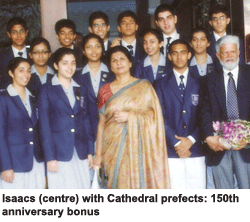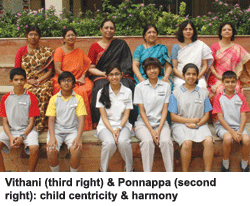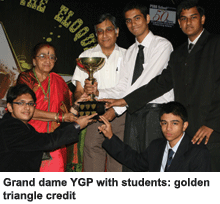The highlight of the EW-C fore survey of day schools is the rise to the very top of Cathedral and John Connon School, Mumbai followed by The Shri Ram School, Delhi and Mallya Aditi International School, Bangalore, both ranked second
 Although some predominantly day schools across the country host small contingents of boarders, for the purposes of this survey they have been included in the day schools league tables. Also it’s important to bear in mind that day schools tend to have local rather than national reputations. Therefore the regional/zonal ranking of day schools is perhaps a more accurate indicator of the quality of institutions in this category with local respondents being more familiar with their histories and track records.
Although some predominantly day schools across the country host small contingents of boarders, for the purposes of this survey they have been included in the day schools league tables. Also it’s important to bear in mind that day schools tend to have local rather than national reputations. Therefore the regional/zonal ranking of day schools is perhaps a more accurate indicator of the quality of institutions in this category with local respondents being more familiar with their histories and track records.
Against this backdrop, the highlight of the 2010 EW-C fore survey of day schools is the rise to the very top of the K-12 Cathedral and John Connon School, Mumbai (estb.1860), with an aggregate score of 1,054. Ironically this winning score is less than the 1,070 that it aggregated last year when it was ranked second, indicating that this year sample respondents have been less generous and more demanding. The second position in the national day schools league table is shared by last year’s top-ranked The Shri Ram School, Delhi and Mallya Aditi International School, Bangalore. The latter’s excellent showing in the latest EW poll is particularly commendable as last year it was misclassified as an international school and ranked 11. But since it doesn’t offer international curriculums in its primary/middle years, it was included in the day schools’ list in which its aggregate has equaled Shri Ram and run Cathedral, Mumbai very close.
Other secondaries which have vaulted into the ranks of the national Top 10 are National Public School, Indiranagar, Bangalore at No. 5 (from 32 last year), Vasant Valley, Delhi to No.9 (17) and Padma Seshadri Bala Bhavan, Chennai also to No.9 (22). The biggest losers of rank this year are La Martiniere for Boys, Kolkata, mired in the Rouvanjit Rawla suicide controversy (which has also adversely affected La Martiniere for Girls) which plunged from No. 3 last year to 14 in 2010. Similarly, the ranking of Bishop Cotton Boys and Bishop Cotton Girls, Bangalore, which were embroiled in bishop vs. principals scandals prompting the resignation of principal John Ellis and transfer of girls’ school principal Princess Franklyn, have suffered a steep fall in reputation from high positions of No. 6 and 14 last year, to 21 and 30 respectively in 2010.
“Naturally, I am delighted as is everyone connected with the school that we have been ranked India’s most respected day school. To be top-ranked this year has special significance as we are currently in the midst of celebrating the school’s 150th anniversary,” says Meera Issacs, who took charge as principal of Cathedral & John Connon in 1996, and is widely credited for upgrading and contemporising this vintage K-12 school. Issacs ascribes Cathedral’s ascent to the head of the day schools national and regional league tables to growing public appreciation of the school’s “global presence on the international stage as an institution that’s not limited by either intellectual or geographical bound-aries”. “This is being understood not just by our main stakeholders —parents, teachers, students and alumni — but also by the world of education in general,” she says.
 Likewise although perplexed by the trough and peak swings of Mallya Aditi International School (MAIS), Bangalore in the EW-C fore league tables during the past three years, Satish Jayarajan, principal and college advisor of MAIS, expresses delight mixed with skepticism. “I am not clear about the basis of the EW-C fore rankings. If it’s a perceptions ranking, I’m prepared for them to be notoriously fickle. Nevertheless I am delighted but not surprised because we have consistently focused on improving teaching and learning outcomes. And it is in these core areas that we have been highly rated. Aditi is a work in constant progress and it is our commitment to constantly strive for excellence that has impressed the public and given us our high ranking this year,” says Jayarajan.
Likewise although perplexed by the trough and peak swings of Mallya Aditi International School (MAIS), Bangalore in the EW-C fore league tables during the past three years, Satish Jayarajan, principal and college advisor of MAIS, expresses delight mixed with skepticism. “I am not clear about the basis of the EW-C fore rankings. If it’s a perceptions ranking, I’m prepared for them to be notoriously fickle. Nevertheless I am delighted but not surprised because we have consistently focused on improving teaching and learning outcomes. And it is in these core areas that we have been highly rated. Aditi is a work in constant progress and it is our commitment to constantly strive for excellence that has impressed the public and given us our high ranking this year,” says Jayarajan.
 Hansa Vithani and Nalini Ponnappa, founder-director and principal respec-tively, of Vidya Niketan School also a Bangalore-based K-12 institution (estb.1985), are unreservedly thrilled by this CISCE-affiliated school’s specta-cular leap forward in the day schools league tables this year. Ranked No. 89 in 2008 and 86 last year, this low-profile school has risen high in the esteem of the discerning public to be ranked No. 10 in 2010. “This recognition of our education improvement efforts is as surprising as it is inspiring. For the past quarter-century we have been conti-nuously working to improve our child-centric and holistic education curriculums. These efforts are reflected in our improved ranking this year,” says Vithani. Adds Ponnappa: “We believe in orchestrated and harmonious team effort and continuous in-service teacher training. I believe it is our focus on these priority areas which has won us public appreciation.”
Hansa Vithani and Nalini Ponnappa, founder-director and principal respec-tively, of Vidya Niketan School also a Bangalore-based K-12 institution (estb.1985), are unreservedly thrilled by this CISCE-affiliated school’s specta-cular leap forward in the day schools league tables this year. Ranked No. 89 in 2008 and 86 last year, this low-profile school has risen high in the esteem of the discerning public to be ranked No. 10 in 2010. “This recognition of our education improvement efforts is as surprising as it is inspiring. For the past quarter-century we have been conti-nuously working to improve our child-centric and holistic education curriculums. These efforts are reflected in our improved ranking this year,” says Vithani. Adds Ponnappa: “We believe in orchestrated and harmonious team effort and continuous in-service teacher training. I believe it is our focus on these priority areas which has won us public appreciation.”
Although the day schools Top 10 table has a majority from Delhi with Mother’s International and Springdales which were jointly ranked No. 10 last year rising to No. 3 and 4 respectively this year, most of the major cities except Kolkata (because of the eclipse of the La Martiniere schools) are represented on the top table. In Mumbai Campion School ranked No.4, has overtaken Bombay Scottish (6) to become the commercial capital’s second most respected school after Cathedral.
In Chennai, Padma Seshadri, which last year was inexplicably ranked a lowly 22 is top-ranked jointly with DAV Boys which has slipped three places in the national league table. In Bangalore, the top two day schools are Mallya Aditi and National Public School, Indiranagar ranked No. 2 and No. 5 nationally. In particular NPS, Indiranagar has made a great leap forward in the public esteem mainly because of its academic reputation on which parameter it is ranked No.1 nationally. Moreover the southern city of Hyderabad is also represented in the Top 10 table with Gitanjali School ranked No. 9 this year.
 “I give full credit for our Top 10 ranking this year to PSBB’s golden triangle — teachers, students and parents who have been working dilige-ntly to improve the school’s performance and public image,” says Dr. Y. G. Parthasarathy, the octogenarian grande dame of primary-secondary education in Chennai and founder of PSBB (estb.1959). “There’s growing appreci-ation of our emphasis on inculcating Indianness in our students; maintaining a scientific approach to learning; nurturing leadership qualities by giving students freedom and opportunity to showcase their skills and talents in varied co-curricular activities and moulding them into responsible citizens who care for others,” says YGP.
“I give full credit for our Top 10 ranking this year to PSBB’s golden triangle — teachers, students and parents who have been working dilige-ntly to improve the school’s performance and public image,” says Dr. Y. G. Parthasarathy, the octogenarian grande dame of primary-secondary education in Chennai and founder of PSBB (estb.1959). “There’s growing appreci-ation of our emphasis on inculcating Indianness in our students; maintaining a scientific approach to learning; nurturing leadership qualities by giving students freedom and opportunity to showcase their skills and talents in varied co-curricular activities and moulding them into responsible citizens who care for others,” says YGP.
Further down the league table, other schools that have impressed the parents and educators’ communities are Step by Step, Noida which has risen from No. 21 last year to No. 11 in 2010; the previously unranked Riverside, Ahmedabad and Sloka, Hyderabad to No. 14 and 15; St. James, Kolkata (55 to 17); Vidyashilp Academy, Bangalore (68 to 20), and Inventure Academy, Bangalore (33 to 23). Amazingly, Inventure (estb. 2005) is ranked above Bishop Cotton Boys (estb. 1865) and Bishop Cotton Girls (estb. 1911), because these schools top-ranked in Bangalore last year, have been victims of unseemly rows within their boards of governors — telling proof of the importance of an unsullied public image.
Among other primary-secondaries which have improved their public image and risen handsomely to be ranked within India’s Top 50 in the EW-C fore 2010 day schools league table are DPS, Noida (80 to 24); St. Mary’s Mazgaon, Mumbai (38 to 26); Springdales, Pusa Road, Delhi (99 to 27); Sishya School, Adyar, Chennai (70 to 31); Chirec Public School, Hyderabad (45 to 32); National Public School, Rajajinagar, Bangalore (64 to 34); St. John’s High, Chandigarh (95 to 35); Smt. Sulochana Devi Singhania School, Thane (unranked to 36); DPS, Ghaziabad (unranked to 39); Army Public School, Dhaula Kuan, Delhi (97 to 42); Carmel Convent, Chandigarh (55 to 43); Air Force Golden Jubilee (unranked to 47); Lotus Valley, Noida (78 to 49) and Kendriya Vidyalaya, IIT- Madras (69 to 50), the country’s highest ranked government school.
It is pertinent — particularly for government officials and educrats who seem completely oblivious of quality issues and public opinion in matters related to education — to note that for a primary and/or secondary school to be included within the Top 100 ranks, indeed within the national league table from which excessively low-profile schools (i.e unknown to a minimum 25 of the 2,062 individuals constituting the sample respondents base) are excluded, is a singular achievement. For the simple reason that with 450 million children below age 18, contemporary India hosts the world’s largest school-enroled population (193 million in class I, excluding children in pre-schools) with over 100 million children enroled in 107,700 private and 65,119 government secondaries.
Consequently previously unranked schools have done well to be included in the the EW-C fore day schools league table 2010. Among the hitherto unranked schools which have debuted this year: Manav Sthali, Rajender Nagar, Delhi (73); Vidyaranya High, Hyderabad (74); DPS, Ruby Park, Kolkata and Apeejay, Nerul, Navi Mumbai (77); Salwan Public, Gurgaon (80); Shaheed Rajpal DAV, Delhi (81); DAV Public, Shreshta Vihar, Delhi, Ahlcon Public, Delhi and Eicher School, Faridabad (all ranked 82); Seth M.R. Jaipuria, Lucknow (86); Shishu-griha, Bangalore (87); Assam Rifles, Shillong (88); Manav Rachna, Faridabad (89); Convent of Jesus & Mary (90); Blue Bells, Delhi (93); PSBB Millennium, Chennai (94); St. Anne’s, Chandigarh (94); Tagore International, Delhi (95) and Udgam School, Ahmedabad (96). Ditto several other primary-secondaries further down the list were sufficiently high-profile to qualify for inclusion in this year’s longer list of 240 day schools (cf. 161 in 2009) league table.
The larger number of institutions included in the 2010 day schools league tables, the substantial number of schools which have debuted in the rankings, and the numerous primary-secondaries which have made efforts to improve their ranking is a socially beneficial development. It’s an indication that school managements are increas-ingly connecting with the public because they are becoming aware of the importance of institutional reput-ation and benchmarking. And that’s the best prescription for raising education standards in primary-secondary educa-tion countrywide.
Download India's Best Day Schools league table userfiles/file/Best%20Day%20Schools%20league%20table.pdf
Download Day Schools Regional league tables userfiles/file/Day-Regional%20tables.pdf
Download Parameters of Excellence: India's Top 10 Day Schools userfiles/file/Day-parameters.pdf